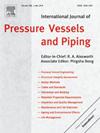Development of stress intensity factor equations for rectangular shaped surface flaws in a plate
IF 3
2区 工程技术
Q2 ENGINEERING, MECHANICAL
International Journal of Pressure Vessels and Piping
Pub Date : 2024-11-29
DOI:10.1016/j.ijpvp.2024.105387
引用次数: 0
Abstract
Finite element computations and development of equations of stress intensity factors for rectangular shaped surface flaws in a plate are presented. Rectangular surface flaws rather than semi-elliptic shapes are assumed here because of the typical features of the stress corrosion crackings (SCCs) that have recently been found at welded joints in nuclear reactor structures: the SCCs are confined in the weld metal and their aspect ratios are large. The assumption of rectangular shaped flaws simplifies modeling especially for those with very large aspect ratios. A way is presented to define the stress intensity factors at the deepest and surface points of the flaws using the J-integral method. Then stress intensity factor equations are developed for a plate subject to stresses that are expressed by polynomial functions of distance from the plate surface.
求助全文
约1分钟内获得全文
求助全文
来源期刊
CiteScore
5.30
自引率
13.30%
发文量
208
审稿时长
17 months
期刊介绍:
Pressure vessel engineering technology is of importance in many branches of industry. This journal publishes the latest research results and related information on all its associated aspects, with particular emphasis on the structural integrity assessment, maintenance and life extension of pressurised process engineering plants.
The anticipated coverage of the International Journal of Pressure Vessels and Piping ranges from simple mass-produced pressure vessels to large custom-built vessels and tanks. Pressure vessels technology is a developing field, and contributions on the following topics will therefore be welcome:
• Pressure vessel engineering
• Structural integrity assessment
• Design methods
• Codes and standards
• Fabrication and welding
• Materials properties requirements
• Inspection and quality management
• Maintenance and life extension
• Ageing and environmental effects
• Life management
Of particular importance are papers covering aspects of significant practical application which could lead to major improvements in economy, reliability and useful life. While most accepted papers represent the results of original applied research, critical reviews of topical interest by world-leading experts will also appear from time to time.
International Journal of Pressure Vessels and Piping is indispensable reading for engineering professionals involved in the energy, petrochemicals, process plant, transport, aerospace and related industries; for manufacturers of pressure vessels and ancillary equipment; and for academics pursuing research in these areas.

 求助内容:
求助内容: 应助结果提醒方式:
应助结果提醒方式:


